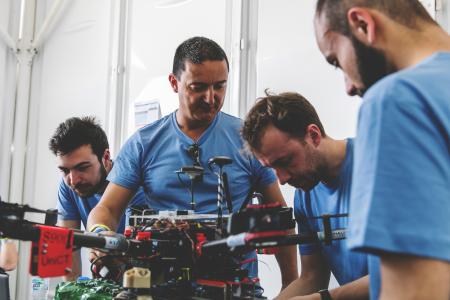Khalifa University of Science and Technology, organizers of the Mohamed Bin Zayed International Robotics Challenge (MBZIRC), today announced a total of 32 teams will be competing for honors at MBZIRC 2020, the second edition of the US$5-million biennial international robotics competition that will be held from 23-25 February in Abu Dhabi, in parallel with the Unmanned System Exhibition (UMEX) and Simulation & Training (SIMTEX) 2020.
Around 500 top robotics experts from 32 international teams from Europe, North America, Asia, Australia and the UAE are preparing for the final leg of MBZIRC 2020 in which they will compete in four iconic robotics challenges that will test advanced embodied AI technical skills. The competition, to be held at the Abu Dhabi National Exhibition Center (ADNEC), will include three challenges and a triathlon type Grand Challenge. MBZIRC 2020 will be co-located with the 4th edition of Unmanned System Exhibition (UMEX) and the Simulation and Training Exhibition and Conference (SimTEX) at ADNEC.
Dr Arif Sultan Al Hammadi, Executive Vice-President, Khalifa University of Science and Technology, said: “Building on the success of the inaugural edition of MBZIRC held in 2017, the second edition of MBZIRC, one of the leading global robotics competitions, will bring a total of 32 teams to the UAE to display their advanced innovations in some key robotics technologies. These finalists represent top internationally-renowned academic and research institutions with well established robotics labs. With such top league participants, we firmly believe MBZIRC 2020 will showcase the creative best in robotics and stand testimony to its reputation as a leading global robotics competition.”
MBZIRC consists of three individual challenges and a grand challenge. Challenge 1 will focus on drone safety, testing whether a team of unmanned aerial vehicles (UAVs) can autonomously track, capture and neutralize intruder UAVs.
Focused on construction automation and robot-based 3D printing of large structures, Challenge 2 will test how a team of UAVs and an unmanned ground vehicle (UGV) can collaborate to autonomously locate, pick, transport and assemble different types of brick-shaped objects to build pre-defined structures, in an outdoor environment.
Motivated by the use of robots for urban firefighting, Challenge 3 will assess how a team of UAVs and a UGV will collaborate to autonomously extinguish a series of simulated fires in an urban high rise building. The Grand Challenge requires a team of robots (UAVs and UGVs) to compete in a triathlon type event, combining Challenges 1, 2 and 3.
These challenges will require participating teams to display their skills and technical advances in fast autonomous navigation in semi-structured, complex, and dynamic environments, with reduced visibility (smoke or hazy conditions) and minimal prior knowledge. They will also be challenged in robust perception and tracking dynamic objects in 3D, sensing and avoiding obstacles, GPS-denied navigation in indoor-outdoor environments, physical interactions, complex mobile manipulations, and air-surface collaboration.




